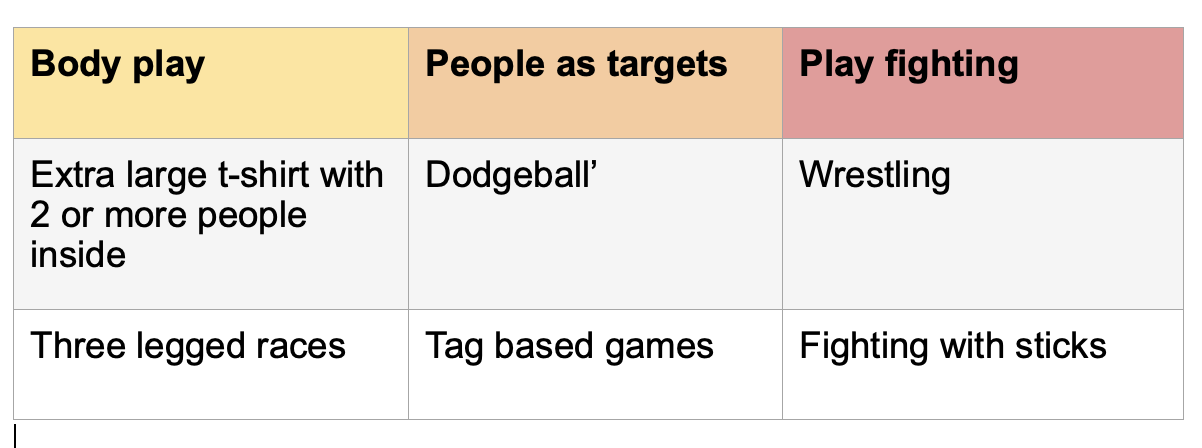A Spectrum of Rough and Tumble Play
Rough and tumble play is often thought to only involve wrestling, weapons and fighting. However, there are many ways that play can involve bodily contact, impact and other forms of ‘rough and tumble’ components. Below are some examples that may help you understand this concept a little more:

Body play
Body play is play that is designed to create bodily contact between people. This type of play affords an opportunity for bodily contact while having a shared goal or experience. For example, tying one child’s leg to another child’s leg necessitates bodily contact in both the upper and lower body, but the two individuals share the goal of trying to move to a different location. This style of rough and tumble play enables the children to develop a sense of how it feels when bodies make contact with each other. This is often a very good first step in creating a culture that encourages rough and tumble play.
People as targets
As we move along the spectrum, impact can take different forms. In this area, activities such as ‘tag’ games or variations of activities such as ‘dodgeball’ may be found. These types of activities involve using the person as the target. This form of play is different to body play as now the goal of the activity is different for different people, such as avoiding being hit or tagged or trying to tag or hit someone else. This type of play also increases the ‘roughness’ in the activity as people are intentionally seeking to touch or hit another person. However, it should be pointed out that these activities should still be played in a way where tagging is done with an open hand, and the balls used when throwing at someone else should be made of foam in order to ensure that no pain is caused to the participants.
Play fighting
Finally, play that involves wrestling or sticks is the end of the spectrum. This play can be very rewarding when done in an open, safe space where everyone understands the parameters of the play. Explicit conversations around consent need to be occurring between the individuals involved in the play and an awareness brought to the fact that someone may get hurt.
This spectrum of rough and tumble play intends to provide ideas and guidelines to caregivers who are looking to engage in this type of activity. These few examples can hopefully ignite some curiosity and creativity for you to begin your journey into rough and tumble activities.
Play with weapons
Children gravitate towards play with weapons as a means to explore role-play, a sense of power, being a superhero, being brave and other imaginative processes. It can be an extremely rich form of play that involves shifting power dynamics, problem solving, empathy, belonging and other cognitive development elements.
People often stay away from imaginary play with weapons as they believe it will lead to the child being more violent later in life or ‘for real’, but there is no evidence to suggest this. Additionally, stopping children from engaging in this type of play is letting them know that their imagination and ideas are ‘wrong’, and making it forbidden can make it more alluring.
At this point, it is important to state that these are not replica weapons, but imaginary weapons. Using a pool noodle as a sword is great, whereas actually using a foam sword can be confusing.
As a caregiver or Early Years Provider, it is important to monitor this play and make sure that it continues to be playful and not aggressive. Keep in mind that you can focus on the play that is occurring in terms of development (cognitive, social, physical etc), and not the content of the play (in this case, weapons).
Source: Chris Wright
